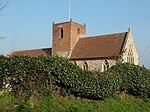South Broads Lifeboat Station
Lifeboat stations in SuffolkLowestoftUse British English from September 2016
South Broads Lifeboat Station was an RNLI operated lifeboat station located on Oulton Broad in the town of Lowestoft in the English county of Suffolk. The station operated between 2001 and 2011. The station covered the southern area of The Broads network, an area of over 100 square miles (260 km2) of inland waterways including the River Waveney. The station performed 194 rescues.
Excerpt from the Wikipedia article South Broads Lifeboat Station (License: CC BY-SA 3.0, Authors).South Broads Lifeboat Station
Caldecott Road, East Suffolk Oulton Broad
Geographical coordinates (GPS) Address Nearby Places Show on map
Geographical coordinates (GPS)
| Latitude | Longitude |
|---|---|
| N 52.477325 ° | E 1.7091388888889 ° |
Address
Caldecott Road
Caldecott Road
NR32 3PH East Suffolk, Oulton Broad
England, United Kingdom
Open on Google Maps










